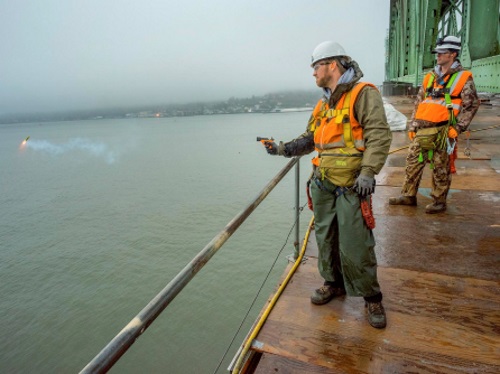The Oregon Department of Transportation has a public outreach message for water birds who want to nest on two of their iconic bridges: Beat it.
[Above: Matt Alex, a wildlife biologist with the U.S. Dept. of Agriculture, fires a “flash pistol” to scare off birds. Photo via the Oregon DOT.]
Officially, Oregon DOT is utilizing an auditory dispersal method to relocate cormorants to facilitate infrastructure maintenance, such as inspection and painting. In practice, a technician fires a pistol that flashes, pops, and whistles. The sounds and lights chase the birds from the bridges.
“It basically is a gun-like mechanism that looks like a fireworks show,” explained Angela Beers Seydel, an Oregon DOT public information officer, in describing a test of the procedure in early March. “It whizzed, it banged, it flashed.”
Both bridges are on U.S. 101, along the Pacific coast. The 4.1-mile Astoria-Megler Bridge crosses the Columbia River and connects Oregon and Washington. It is the longest continuous truss bridge in the U.S., and painting it takes more than eight years and about $75 million.
Meanwhile, the Yaquina Bay Bridge – located about 300 miles south – is an 88-year-old arch structure built by the Public Works Administration; a depression-era federal program that also financed the Lincoln Tunnel and Hoover Dam. Conde McCullough, a renowned Oregon DOT engineer (he has his own Wikipedia page) designed the Yaquina Bay Bridge – along with 14 others along U.S. 101.
The sound-and-light program will continue through September on the Astoria-Megler Bridge and through June on the Yaquina Bay Bridge.

“These birds affect our ability to conduct inspections,” noted Don Hamilton, an Oregon DOT spokesperson. He added that those inspections occur at least every two years, but that cannot happen if birds, bird nests, or bird “guano” are on the bridge. Guano, or bird droppings, also have a corrosive effect on bridges and can be toxic to humans.
One or two technicians go on the U.S. 101 bridges every day and fire off several rounds.
Seydel said the sensory assaults take place at random times “so the birds don’t recognize a pattern. You want them to be uncomfortable to be in that area.”
Recently, Oregon DOT used propane cannons, which produce louder and deeper sounds, to successfully chase away birds from the Interstate 5 bridge over the Columbia River. Seydel said Oregon DOT might bring out those “big guns” if the pistol sounds and flashes do not work on the U.S. 101 bridges.
“There’s also the canon, if necessary,” she said. “So, whiz, bang, boom is the possibility.”

